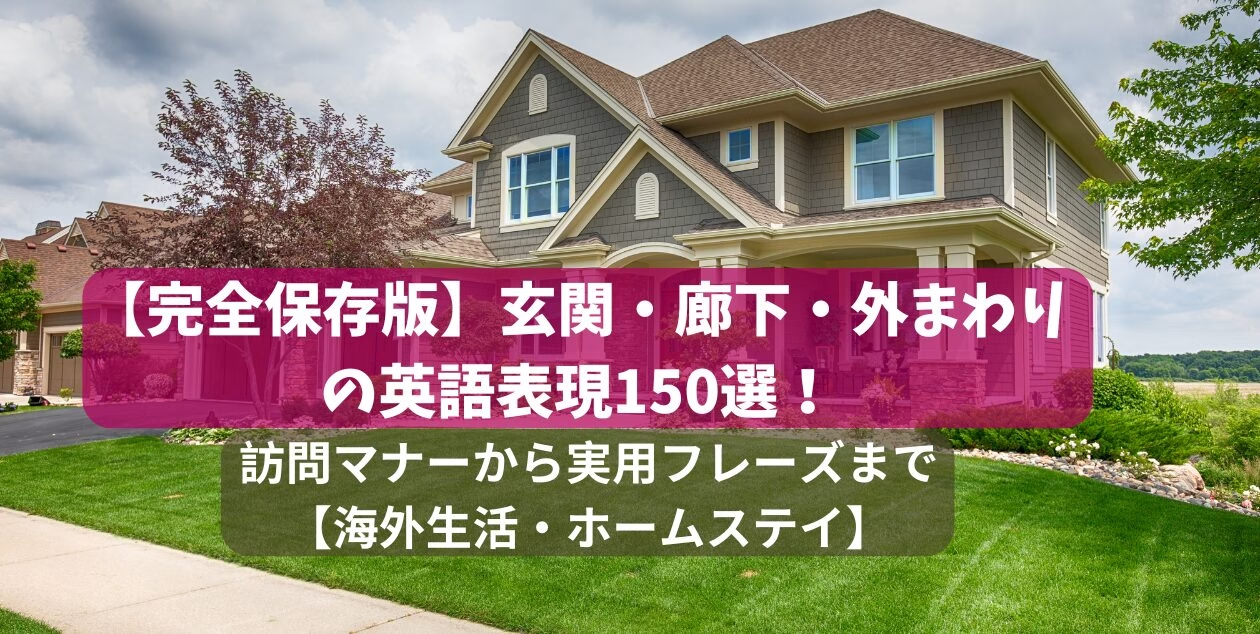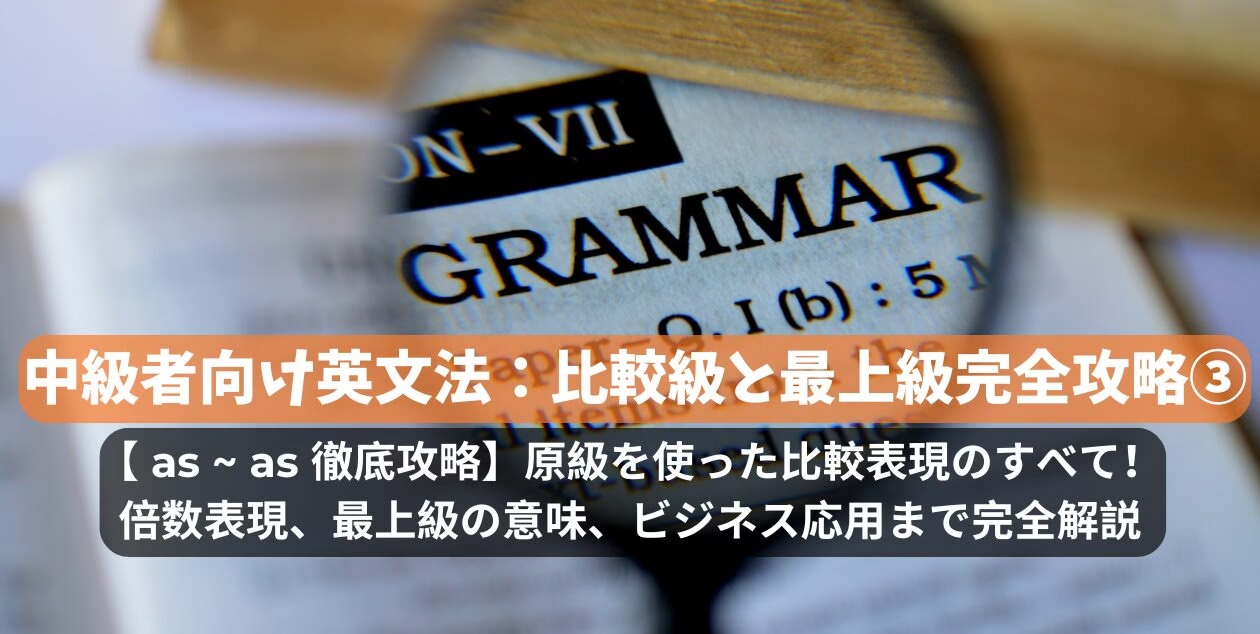「英語で日常会話をしたいけれど、身近な場所の表現がわからない」「外国の友人を家に招待したいが、玄関まわりの説明ができない」そんな悩みを抱えている英語学習者の方は多いのではないでしょうか。
実は、玄関や廊下、家の外まわりに関する英語表現は、日常会話において非常に重要な役割を果たしています。これらの表現をマスターすることで、より自然で実践的な英会話ができるようになります。
この記事では、玄関まわりから防犯設備、庭・外構、そして訪問時のマナーまで、150を超える実用的な英語表現を発音記号、詳しい解説、例文とともに紹介します。日常生活で使える表現を身につけて、英会話のレベルアップを図りましょう。
1. 玄関まわりの基本英語表現

玄関の基本構造
entrance
- 発音記号: /ˈentrəns/
- 意味: 入口
- 解説:建物や家の出入り口全般を指す基本単語
- 例文:Please use the main entrance.
- 和訳:正面玄関をお使いください。

front door
- 発音記号:/frʌnt dɔːr/
- 意味: 玄関ドア
- 解説:家の正面にある出入り口を指す
- 例文:She left the keys at the front door.
- 和訳:彼女は玄関に鍵を置き忘れた。
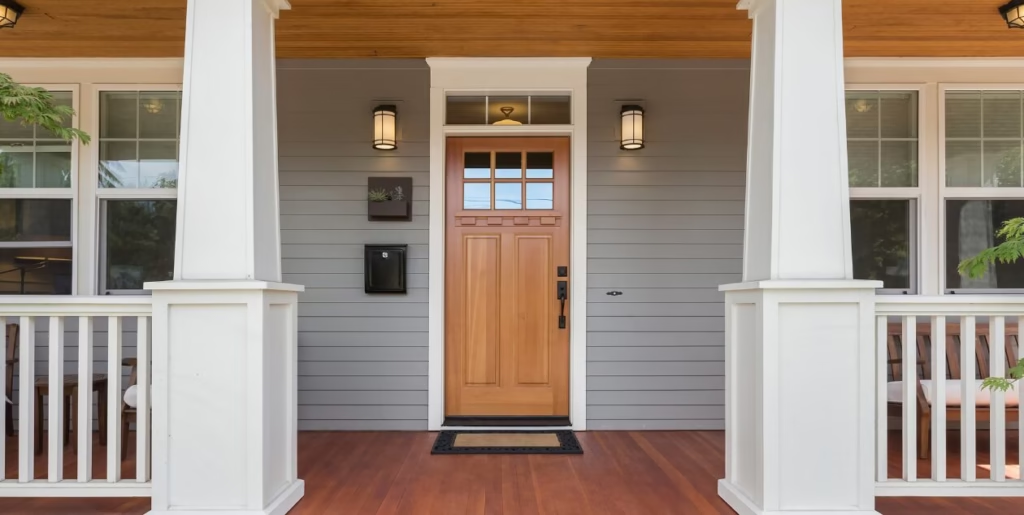
doorknob
- 発音記号:/ˈdɔːr nɑːb/
- 意味: ドアノブ
- 解説:ドアを開閉するための取っ手
- 例文:The doorknob is loose; it needs to be fixed.
- 和訳:ドアノブが緩んでいるので修理が必要だ。
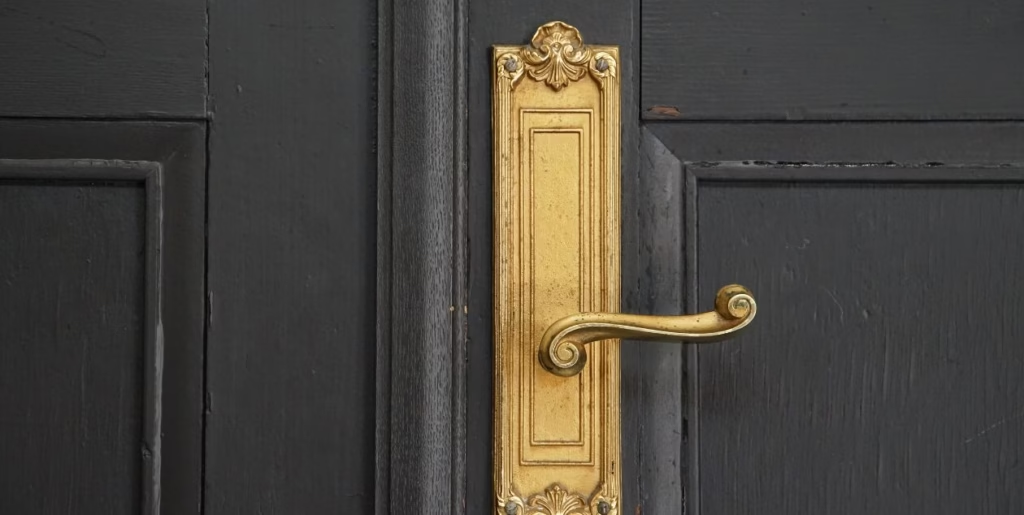
doorbell
- 発音記号: /ˈdɔːr bel/
- 意味: ドアベル
- 解説:訪問者が玄関で押す呼び出しベル
- 例文:Someone rang the doorbell this morning.
- 和訳:今朝誰かが玄関のベルを鳴らした。

玄関に置かれるアイテム
door mat / welcome mat
- 発音記号:/ˈdɔːr mæt/
- 意味: 玄関マット・ウェルカムマット
- 解説:靴の泥を落とすマットで、「Welcome」と書かれていることも多い
- 例文:Please wipe your shoes on the door mat.
- 和訳:玄関マットで靴を拭いてください。

umbrella stand
- 発音記号:/ʌmˈbrelə stænd/
- 意味: 傘立て
- 解説:傘をまとめて立てておく容器
- 例文:The umbrellas are in the umbrella stand by the door.
- 和訳:傘は玄関横の傘立てにあります。
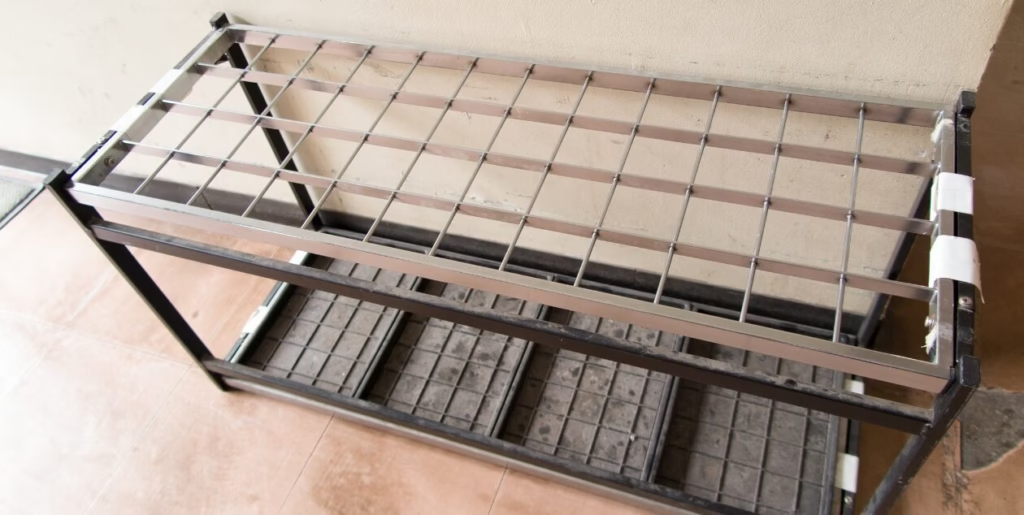
shoe rack / shoe shelf
- 発音記号:/ʃuː ræk/
- 意味: 靴箱・靴棚
- 解説:靴を整理して置く家具。海外では下駄箱よりオープン収納が多い
- 例文:Please put your shoes on the shoe rack.
- 和訳:靴を靴棚に置いてください。
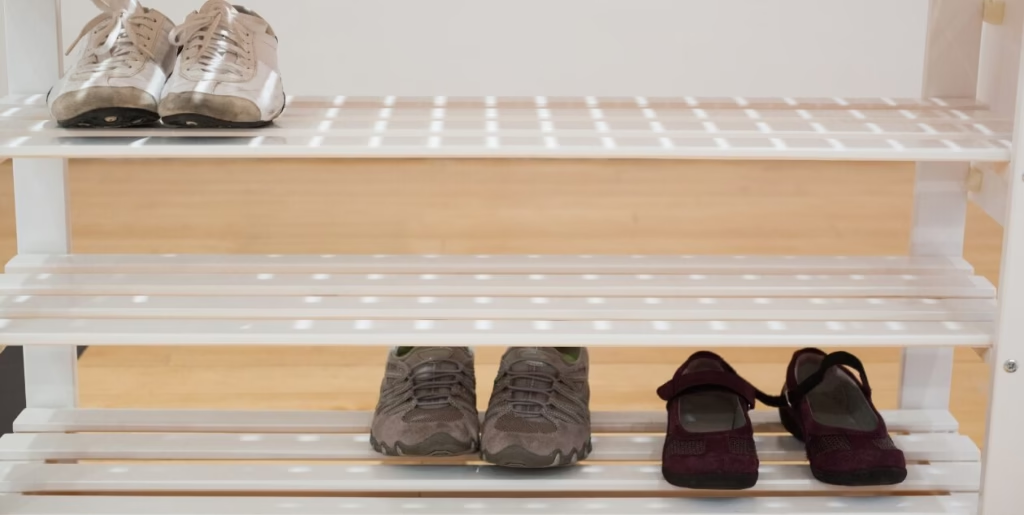
slippers
- 発音記号:/ˈslɪpərz/
- 意味: スリッパ
- 解説:室内用の履物。来客用に用意する家庭もある
- 例文:Take off your shoes and wear the slippers.
- 和訳:靴を脱いでこのスリッパに履き替えてください。

2. 廊下・室内構造の英語表現

廊下の基本表現
hallway / corridor
- 発音記号:/ˈhɔːl.weɪ/・/ˈkɔːrɪdɔːr/
- 意味: 廊下
- 解説:部屋と部屋をつなぐ通路。「hallway」が住宅、「corridor」が公共施設でよく使われる
- 例文:Her room is at the end of the hallway.
- 和訳:彼女の部屋は廊下の突き当たりにあります。
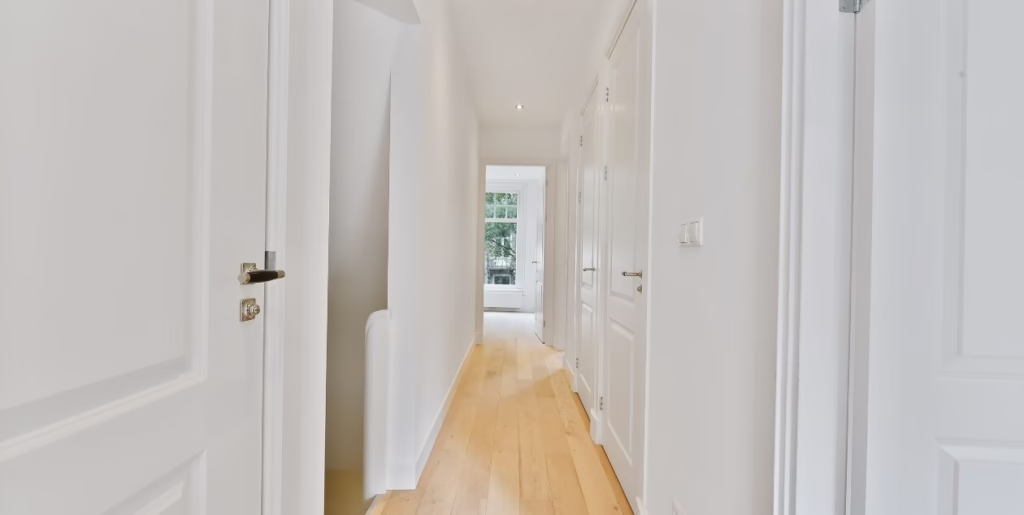
railings / handrail
- 発音記号:/ˈreɪlɪŋz/・/ˈhændreɪl/
- 意味: 手すり
- 解説:階段や廊下の壁側に設置される支え
- 例文:Please hold the handrail when going down the stairs.
- 和訳:階段を下りるときは手すりをお持ちください。
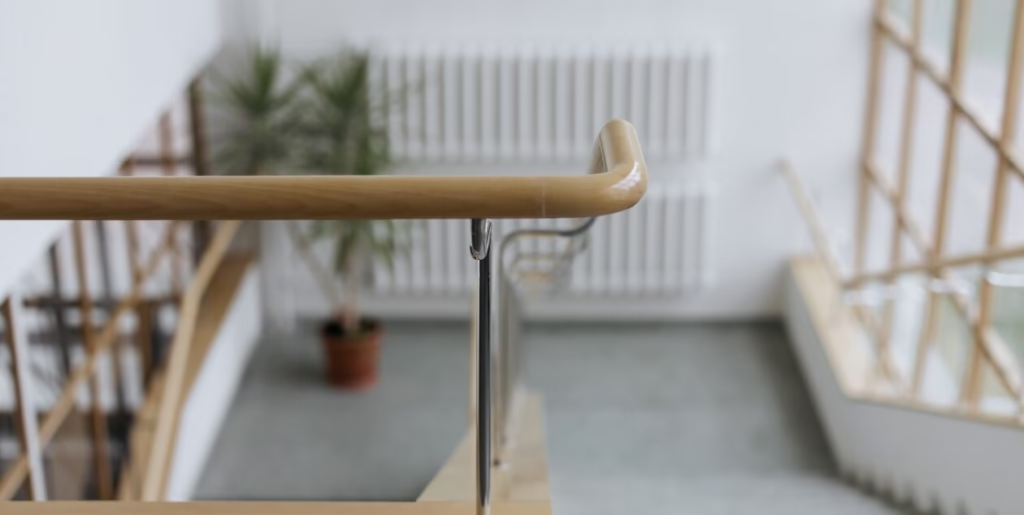
廊下の設備
light switch
- 発音記号:/laɪt swɪtʃ/
- 意味: 電気のスイッチ
- 解説:廊下にある照明のオン・オフ切替
- 例文:The light switch is next to the door.
- 和訳:ライトのスイッチはドアの横にあります。
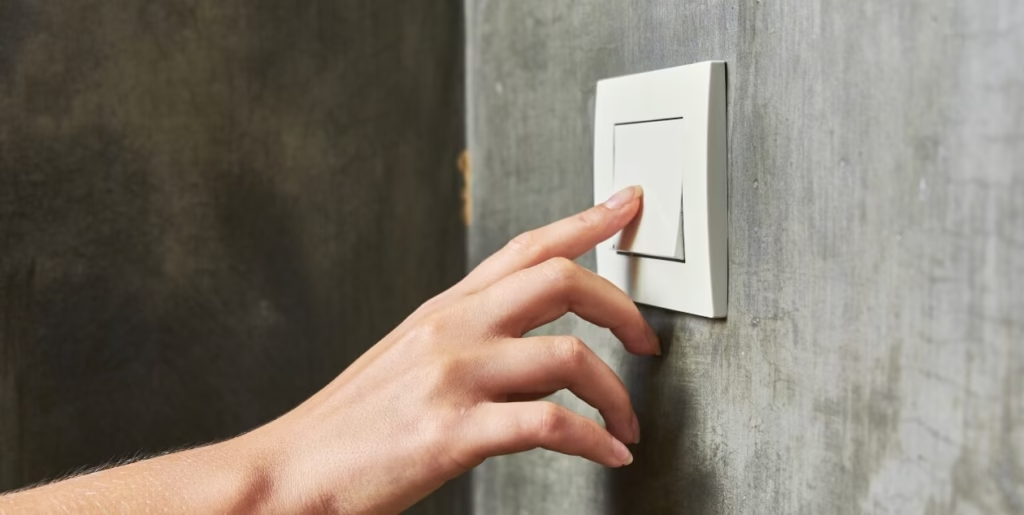
step / threshold
- 発音記号:/stɛp/・/ˈθreʃhoʊld/
- 意味: 段差・敷居
- 解説:「threshold」は室内外を分ける敷居の部分も指す
- 例文:Be careful at the threshold; it’s a bit high.
- 和訳:敷居に気をつけて、少し高いです。
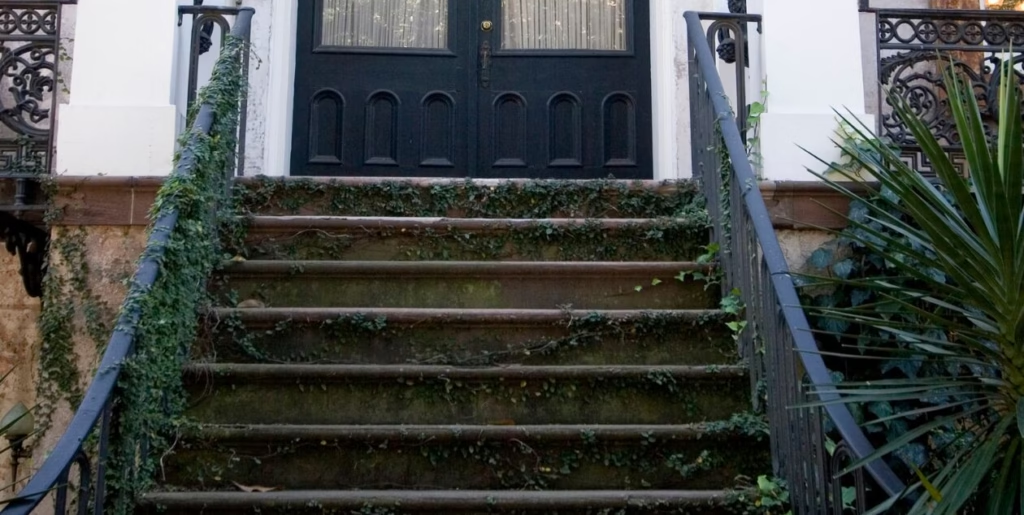
3. 家の外まわりの英語表現

建物の外観構造
porch
- 発音記号:/pɔːrtʃ/
- 意味: ポーチ(家の入口の張り出し部分)
- 解説:欧米住宅によくある雨よけやくつろぎ用のスペース
- 例文:We sat on the porch and drank tea.
- 和訳:玄関先のポーチに座ってお茶を飲みました。

nameplate / doorplate
- 発音記号:/ˈneɪmpleɪt/
- 意味: 表札
- 解説:玄関脇の名前札。海外では必ずしもなく、郵便受けに名前を書く場合もある
- 例文:Their nameplate is next to the front door.
- 和訳:表札は玄関の横にあります。

mailbox / letterbox
- 発音記号:/ˈmeɪl.bɑːks/
- 意味: 郵便受け
- 解説:郵便物を投函するための箱。アメリカでは独立型、日本の集合住宅では埋め込み型が多い
- 例文:The mailbox is full of letters.
- 和訳:郵便受けが手紙でいっぱいだ。

intercom / door phone
- 発音記号:/ˈɪntərkɑm/
- 意味: インターホン
- 解説:玄関先の訪問者と会話できる装置
- 例文:She answered the intercom before opening the door.
- 和訳:彼女はドアを開ける前にインターホンに出た。
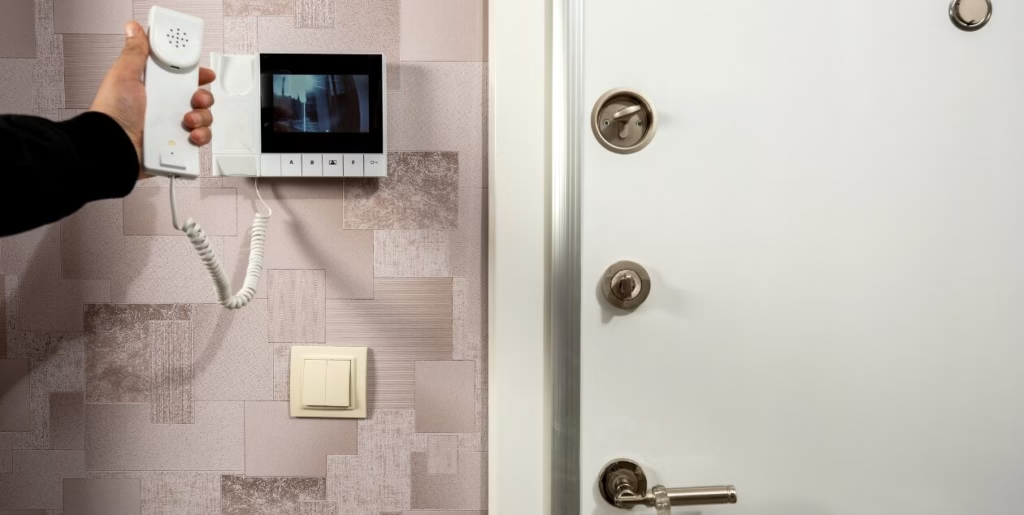
敷地の境界
gate
- 発音記号:/ɡeɪt/
- 意味: 門
- 解説:家や庭の入口部分
- 例文:The front gate is locked at night.
- 和訳:正門は夜間施錠されます。

fence
- 発音記号:/fens/
- 意味: フェンス、柵
- 解説:敷地を区切る囲い
- 例文:They built a wooden fence around their house.
- 和訳:彼らは家の周りに木のフェンスを建てました。

アプローチと駐車場
pathway / walkway
- 発音記号: /ˈpɑːθweɪ/・/ˈwɔːkweɪ/
- 意味: 小道・アプローチ
- 解説:玄関までの道。欧米の住宅で玄関を強調する配置に多い
- 例文:The walkway leads to the front door.
- 和訳:その小道は玄関へと続いている。

driveway
- 発音記号:/ˈdraɪvweɪ/
- 意味: 車道・私道
- 解説:自宅と道路をつなぐ駐車スペース
- 例文:You can park your car in the driveway.
- 和訳:車は私道に停められます。

garage
- 発音記号:/ɡəˈrɑːʒ/・/ɡəˈrɑːdʒ/
- 意味: ガレージ
- 解説:車の保管場所。アメリカでは家に付属している場合が多い
- 例文:The garage door won’t open.
- 和訳:ガレージのドアが開きません。

4. 防犯設備の英語表現

防犯カメラ・監視システム
security camera / surveillance camera
- 発音記号:/sɪˈkjʊərəti ˈkæmrə/
- 意味: 防犯カメラ
- 解説:防犯や監視用のカメラ
- 例文:The security camera records all visitors at the entrance.
- 和訳:防犯カメラは玄関の訪問者をすべて記録します。

security system
- 発音記号:/sɪˈkjʊərəti ˈsɪstəm/
- 意味: セキュリティシステム
- 解説:防犯設備全般を指す用語。アラームやセンサーを含む
- 例文:Our home security system alerts the police in case of intrusion.
- 和訳:我が家のセキュリティシステムは不法侵入があれば警察に通報します。
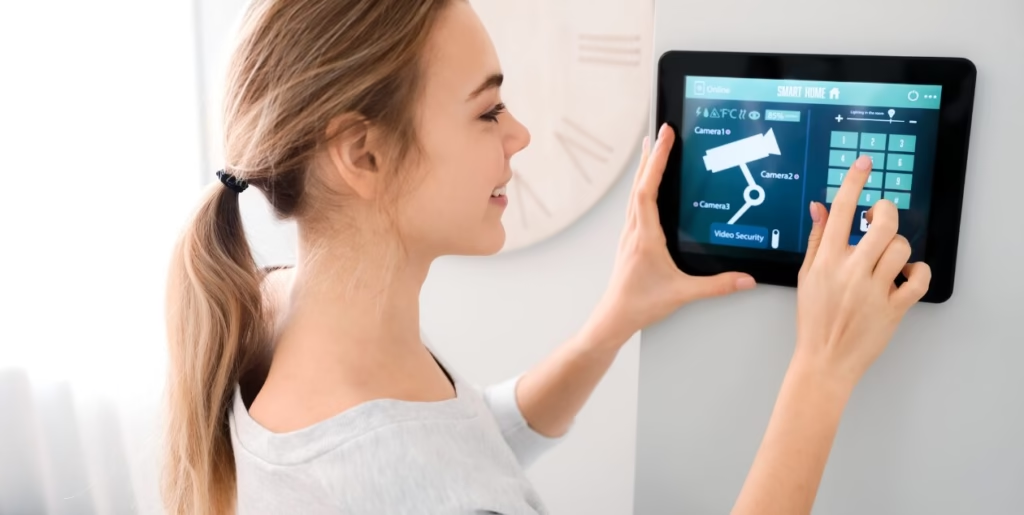
アラーム・センサー
alarm system / burglar alarm
- 発音記号:/əˈlɑːrm ˈsɪstəm/・/ˈbɜːrɡlər əˈlɑːrm/
- 意味: 警報装置・防犯ベル
- 解説:窓やドアが不正に開けられると音が鳴る仕組み
- 例文:The burglar alarm went off at midnight.
- 和訳:防犯アラームが真夜中に鳴り響いた。

motion sensor / motion detector
- 発音記号: /ˈmoʊʃən ˈsensər/・/ˈditɛktər/
- 意味: 人感センサー
- 解説:動きを感知する装置。照明やアラームに連動
- 例文:The motion sensor light turned on when he walked by.
- 和訳:彼が通りかかったとき、人感センサーのライトが点灯した。
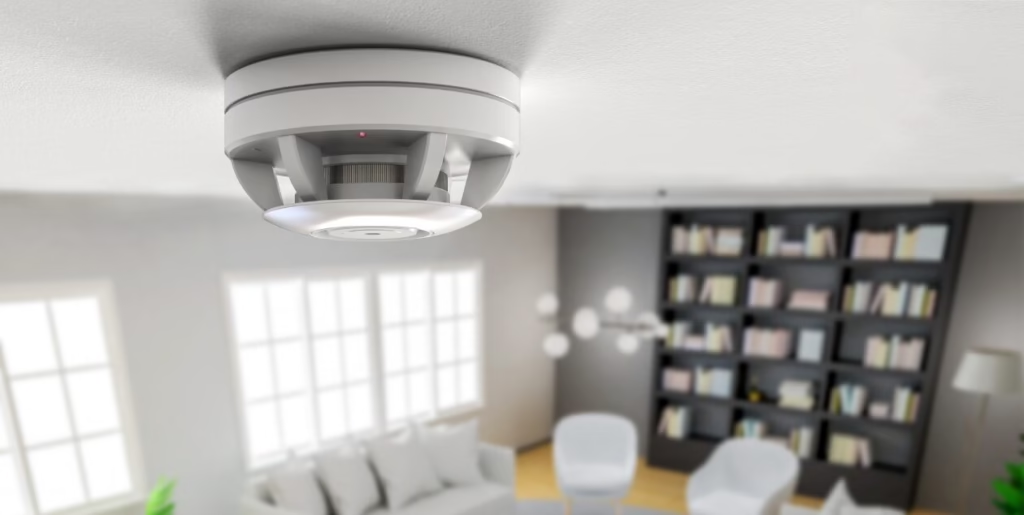
防犯照明・鍵
security light / floodlight
- 発音記号: /sɪˈkjʊərəti laɪt/・/ˈflʌdlaɪt/
- 意味: 防犯ライト・投光器
- 解説:夜間、人の動きを感知して点灯することが多い
- 例文:The security light helps deter trespassers.
- 和訳:防犯ライトは不審者の侵入を防ぐのに役立ちます。
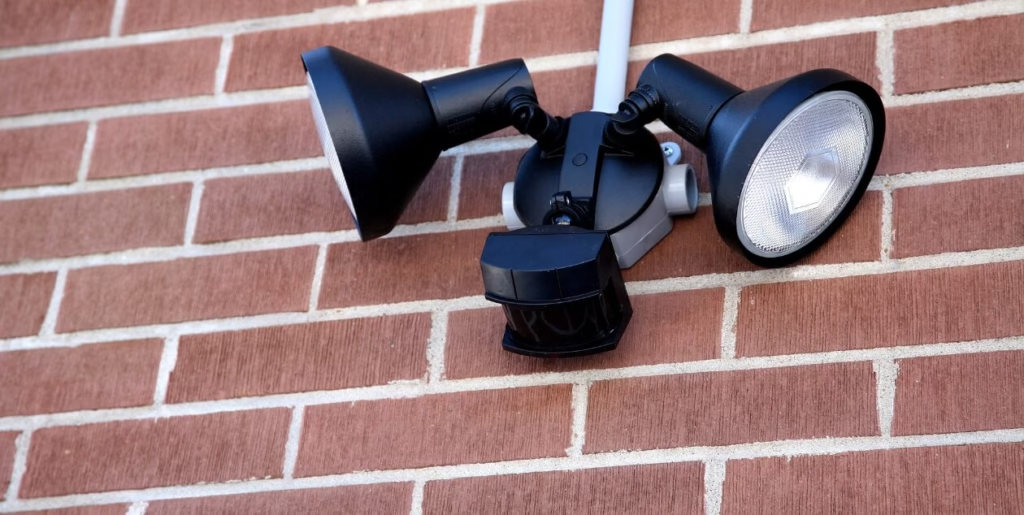
lock / deadbolt lock
- 発音記号:/lɑːk/・/ˈdedboʊlt/
- 意味: 錠前・デッドボルト錠
- 解説:より頑丈な鍵を示す表現
- 例文:Always lock the deadbolt before going to bed.
- 和訳:寝る前に必ずデッドボルトを締めてください。
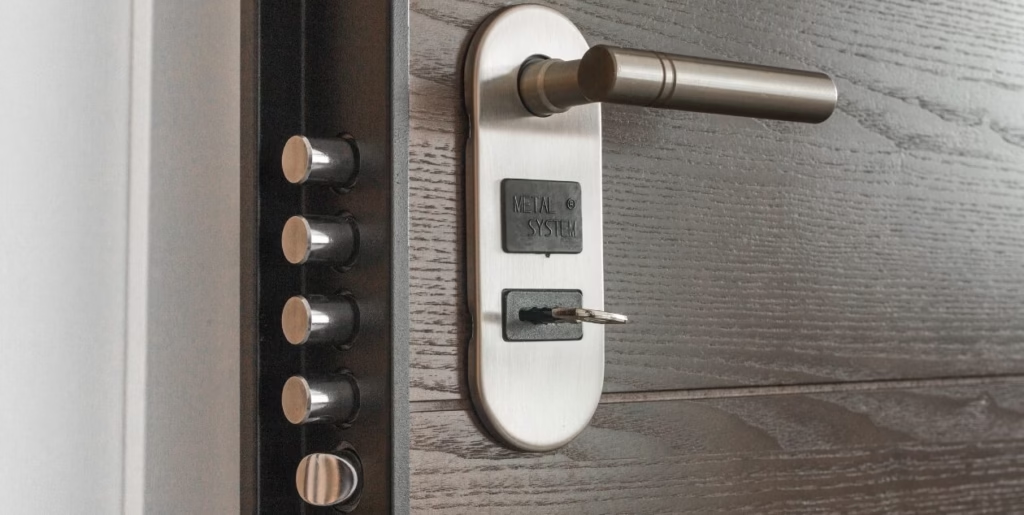
5. 庭・外構まわりの英語表現

庭の基本表現
yard / garden
- 発音記号:/jɑːrd/・/ˈɡɑːrdn/
- 意味: 庭
- 解説:アメリカ英語では「yard」が一般的、イギリスでは「garden」
- 例文:The children are playing in the yard.
- 和訳:子どもたちは庭で遊んでいる。

front yard / backyard
- 発音記号:/frʌnt jɑːrd/・/ˈbækjɑːrd/
- 意味: 前庭・裏庭
- 解説:家の前側と裏側の庭を区別
- 例文:We had a barbecue in the backyard.
- 和訳:裏庭でバーベキューをした。

庭の構成要素
lawn
- 発音記号:/lɔːn/
- 意味: 芝生
- 解説:庭の芝生部分
- 例文:He mows the lawn every weekend.
- 和訳:彼は毎週末芝を刈ります。

hedge
- 発音記号:/hedʒ/
- 意味: 生け垣
- 解説:敷地を区切る木や低木の列
- 例文:A tall hedge surrounds the property.
- 和訳:高い生け垣が敷地を囲んでいる。
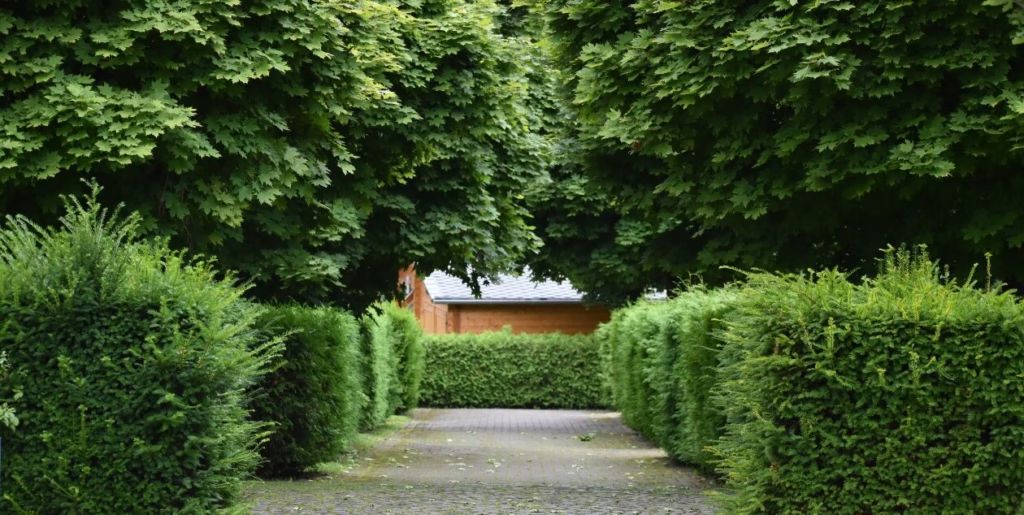
flower bed
- 発音記号:/ˈflaʊər bɛd/
- 意味: 花壇
- 解説:庭に設けられた花を植える区画
- 例文:She planted roses in the flower bed.
- 和訳:彼女は花壇にバラを植えた。

アウトドアスペース
patio / terrace
- 発音記号:/ˈpæti.oʊ/・/ˈterəs/
- 意味: パティオ・テラス
- 解説:家の裏庭や横に作られる屋外スペース
- 例文:We had dinner on the patio.
- 和訳:私たちはパティオで夕食をとった。
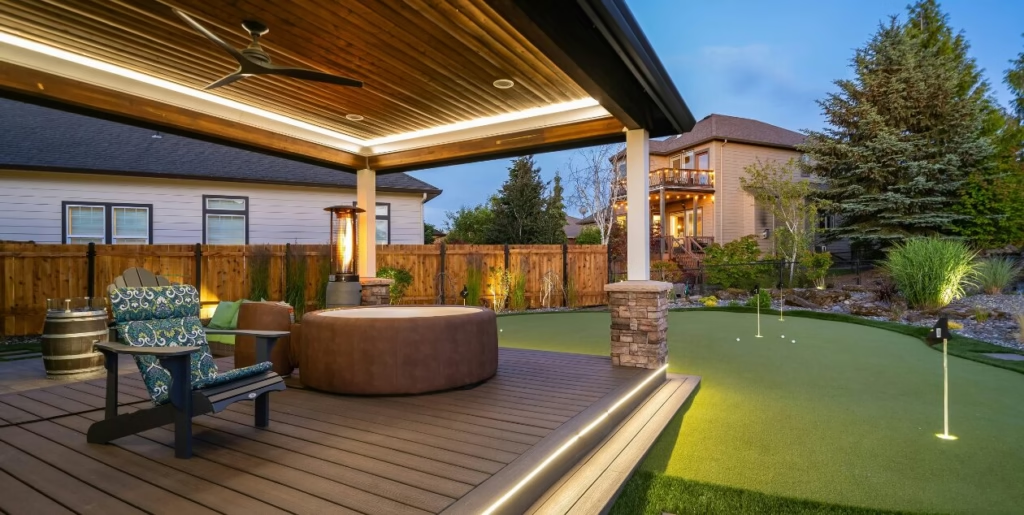
deck
- 発音記号:/dek/
- 意味: デッキ(木製のテラス)
- 解説:アウトドアリビングとして使う木造の床面
- 例文:The deck is perfect for summer parties.
- 和訳:そのデッキは夏のパーティーにぴったりです。

6. 照明関係の英語表現

外灯・玄関照明
porch light
- 発音記号: /pɔːrtʃ laɪt/
- 意味: ポーチライト・玄関灯
- 解説:家の出入口上部に設置される外灯
- 例文:Don’t forget to turn on the porch light at night.
- 和訳:夜は玄関灯を点けるのを忘れないで。
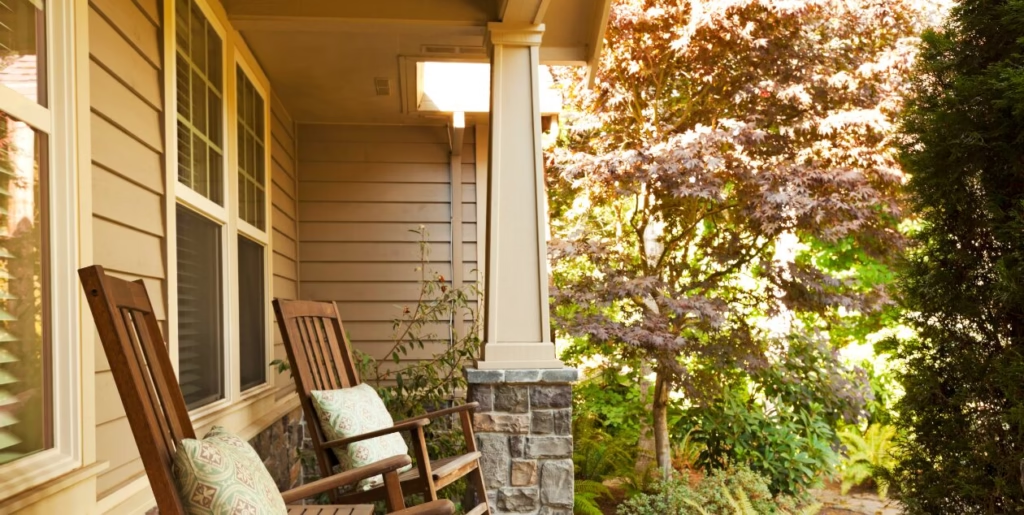
garden light / landscape lighting
- 発音記号:/ˈɡɑːrdn laɪt/
- 意味: 庭園灯・屋外照明
- 解説:庭や小道を照らすためのライト
- 例文:Garden lights make the yard look beautiful at night.
- 和訳:庭園灯は夜の庭を美しく見せてくれる。
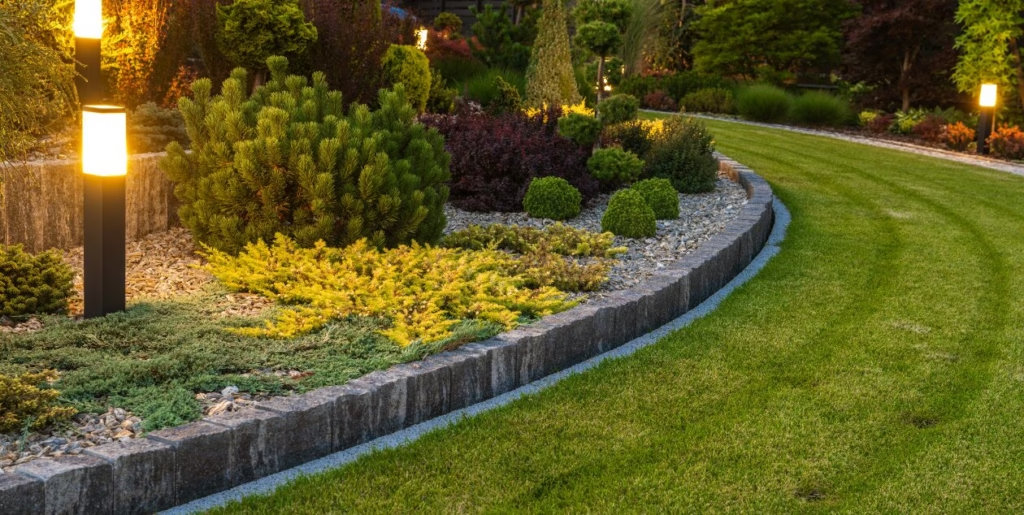
特殊照明
path light
- 発音記号:/pæθ laɪt/
- 意味: 小道の足元灯
- 解説:道沿いに低く配置される照明
- 例文:The path lights guide you safely to the door.
- 和訳:小道の照明が安全に玄関まで導いてくれる。
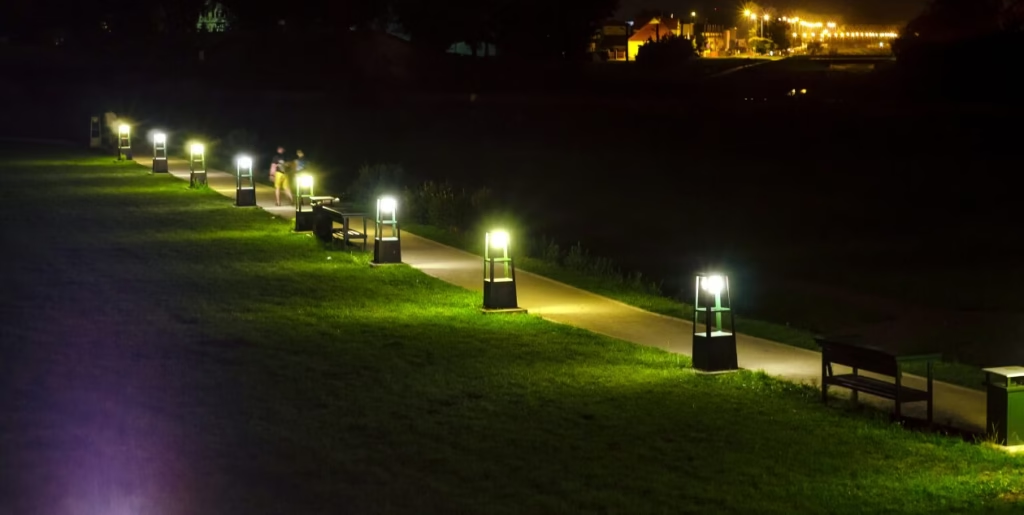
wall-mounted light / sconce
- 発音記号:/wɔːl maʊntɪd laɪt/・/skɒns/
- 意味: 壁付け灯
- 解説:外壁や廊下に固定するランプ
- 例文:They installed wall-mounted lights along the corridor.
- 和訳:廊下に壁付け照明を取り付けた。

sensor light / motion-activated light
- 発音記号: /ˈsɛnsər laɪt/
- 意味: センサーライト
- 解説:人や動きを感知して自動点灯するライト
- 例文:A motion-activated light went on when I entered the yard.
- 和訳:庭に入ったとき、センサーライトが点いた。
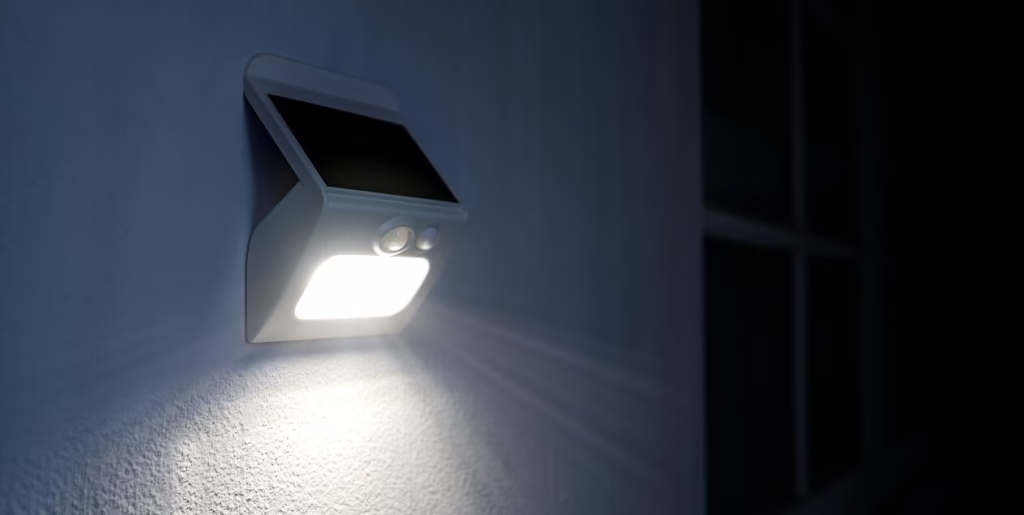
7. 訪問シーンで使う動詞表現
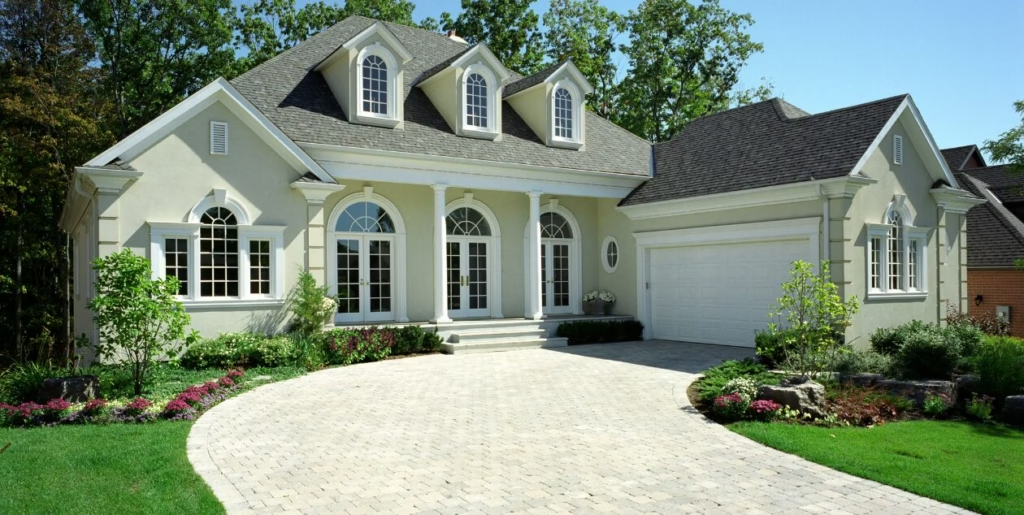
① 家に近づく表現
walk up the driveway / walkway
- 発音記号:/wɑːk ʌp ðə ˈdraɪvweɪ/
- 意味: 私道や小道を歩いていく
- 解説:玄関まで続く私道やアプローチを歩くときの表現
- 例文:I walked up the driveway to the front door.
- 和訳:私は私道を歩いて玄関まで行った。
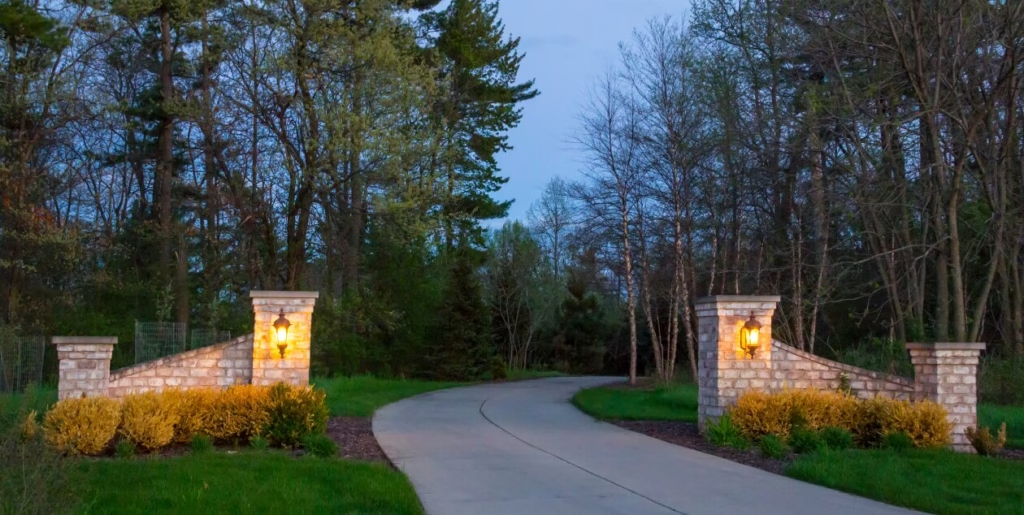
head toward the entrance
- 発音記号:/hed təˈwɔːrd ði ˈentrəns/
- 意味: 玄関に向かう
- 解説:「〜に向かう」を意味する一般的表現
- 例文:She headed toward the entrance with a smile.
- 和訳:彼女は笑顔で玄関に向かった。
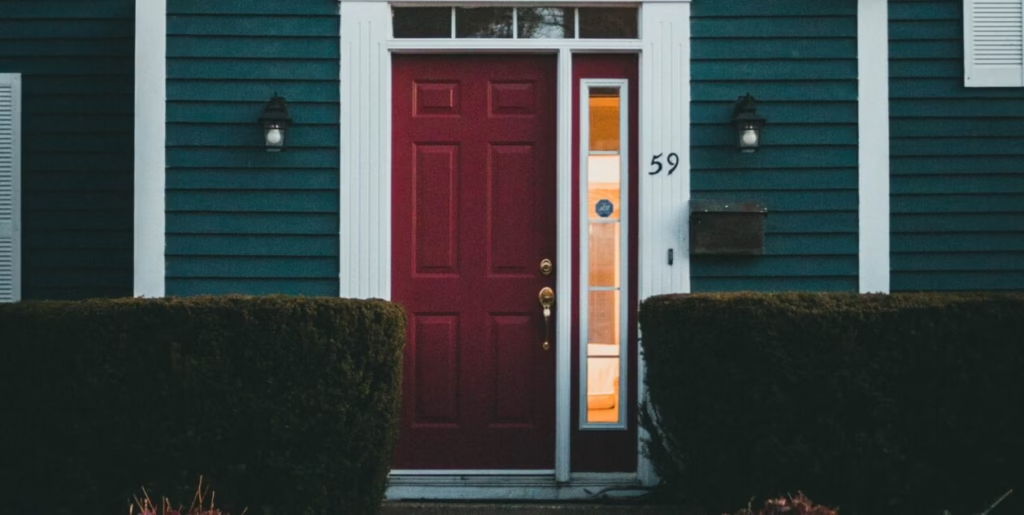
go through the gate
- 発音記号:/ɡoʊ θruː ðə ɡeɪt/
- 意味: 門をくぐる
- 解説:前庭や敷地を囲むゲートを開けて中へ入る動作
- 例文:He went through the garden gate.
- 和訳:彼は庭の門を通った。

② 玄関前での動作
step onto the porch / doorstep
- 発音記号:/stɛp ˈɒntuː ðə pɔːrtʃ/
- 意味: ポーチや玄関先に上がる
- 解説:玄関前の段やポーチに立つときの言い方
- 例文:I stepped onto the porch and looked for the doorbell.
- 和訳:私はポーチに上がってベルを探した。
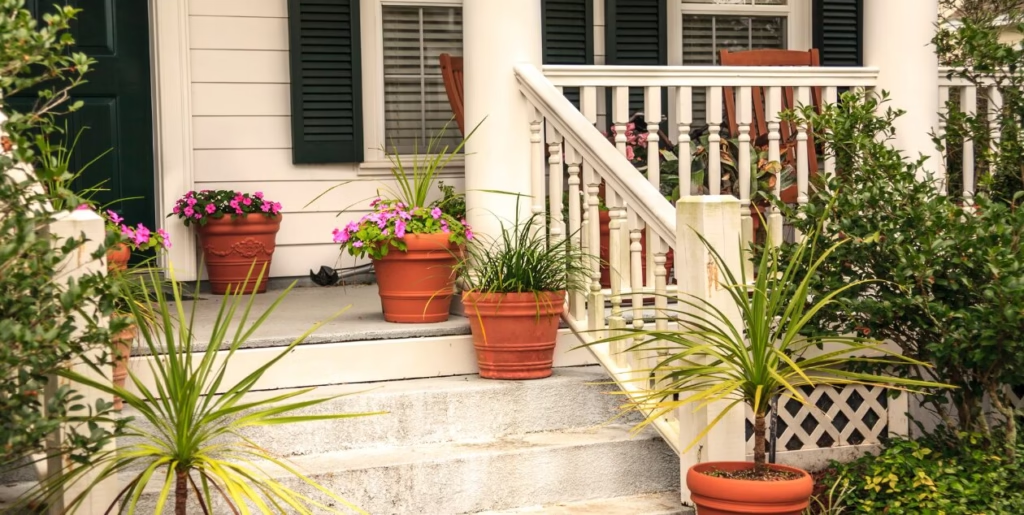
ring the doorbell / press the intercom
- 発音記号:/rɪŋ ðə ˈdɔːrbɛl/・/prɛs ði ˈɪntərkɑːm/
- 意味: チャイムを鳴らす・インターホンを押す
- 解説:訪問時の基本動作。intercomは日本的住宅でもお馴染み
- 例文:She rang the doorbell twice.
- 和訳:彼女はベルを2回鳴らした。
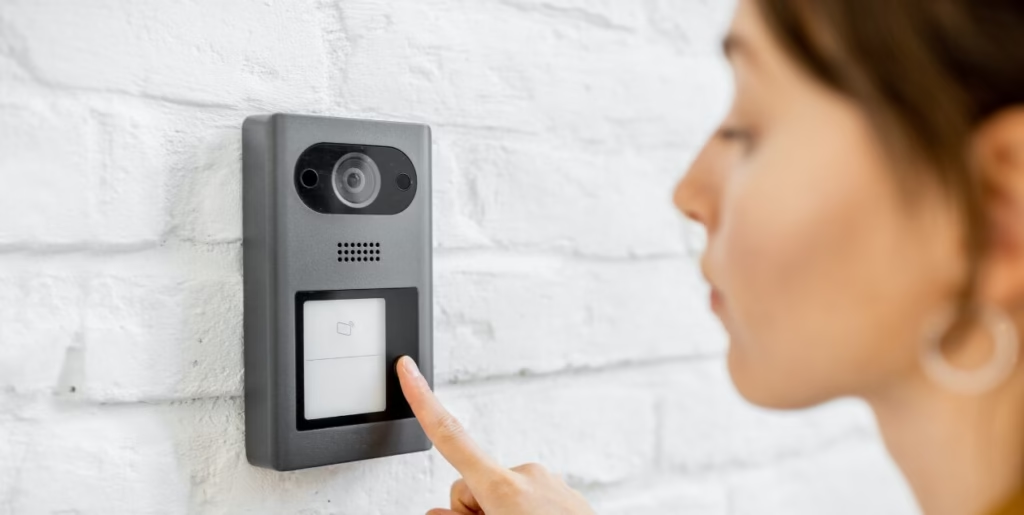
knock on the door
- 発音記号:/nɑːk ɒn ðə dɔːr/
- 意味: ドアをノックする
- 解説:チャイムがないときや補助的に用いる表現
- 例文:He knocked on the door politely.
- 和訳:彼は丁寧にドアをノックした。
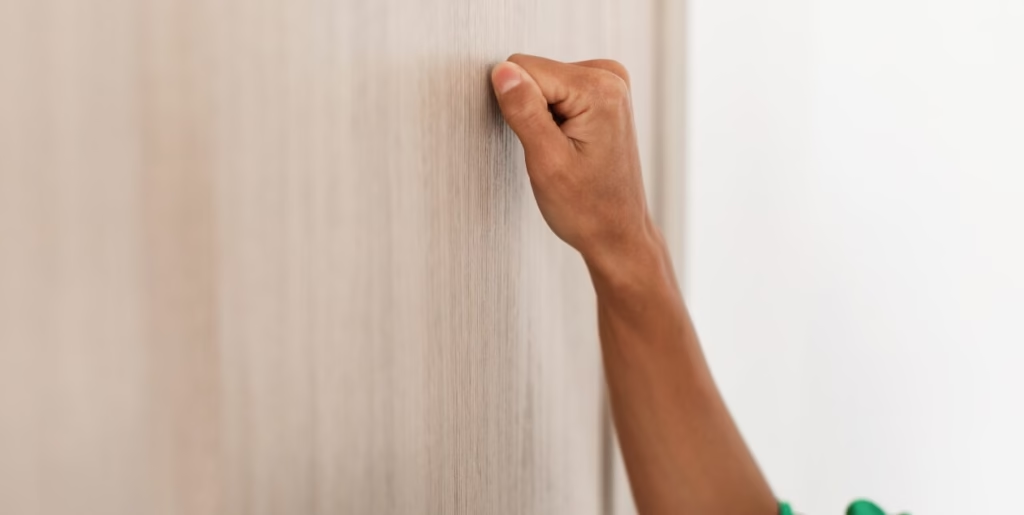
wait at the door
- 発音記号:/weɪt æt ðə dɔːr/
- 意味: 玄関前で待つ
- 解説:返事があるまでドアの前で待機する場面
- 例文:We waited at the door until they answered.
- 和訳:私たちは返事があるまで玄関前で待った。
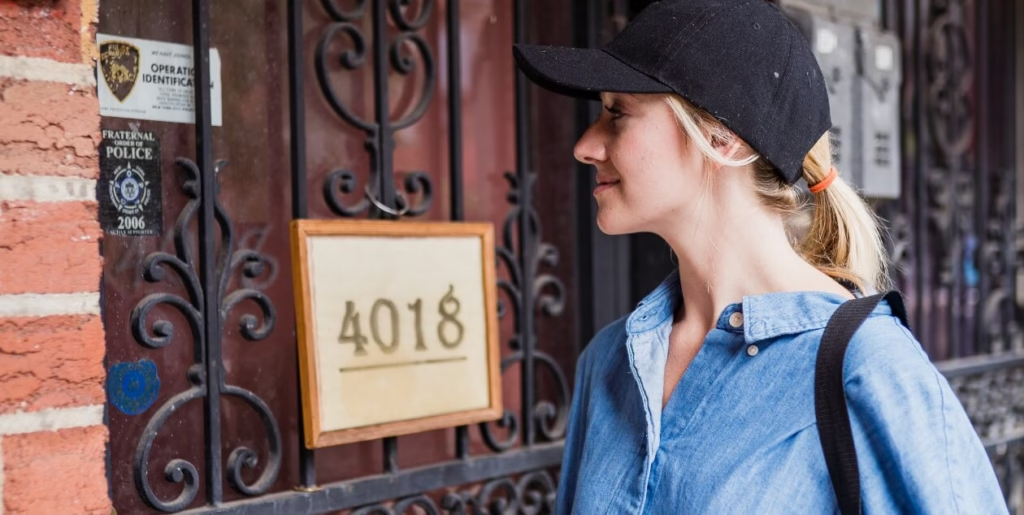
③ ドアが開いたとき
greet the homeowner / host
- 発音記号:/ɡriːt ðə ˈhoʊmˌoʊnər/
- 意味: 家の人に挨拶する
- 解説:玄関で来客が相手と顔を合わせた瞬間に行う動作
- 例文:We greeted the host at the door.
- 和訳:玄関で家の人に挨拶をした。

shake hands / exchange greetings
- 発音記号:/ʃeɪk hændz/
- 意味: 握手する/挨拶を交わす
- 解説:社交的な初対面の場でよく起こる行動
- 例文:They shook hands warmly at the entrance.
- 和訳:彼らは玄関で温かく握手を交わした。

be invited in / be welcomed inside
- 発音記号:/bi ɪnˈvaɪtɪd ɪn/
- 意味: 中に迎え入れられる
- 解説:ホストに「どうぞ」と促され入室する流れ
- 例文:She invited me in right away.
- 和訳:彼女はすぐに私を中に招き入れてくれた。

④ 靴を脱ぐ・入室準備
step inside
- 発音記号:/stɛp ɪnˈsaɪd/
- 意味: 家の中に一歩入る
- 解説:玄関から中へ足を踏み入れるときの基本表現
- 例文:I stepped inside the entryway.
- 和訳:私は玄関の内側に入った。

take off one’s shoes
- 発音記号:/teɪk ɒf wʌnz ʃuːz/
- 意味: 靴を脱ぐ
- 解説:日本文化で特に必須。海外では「靴を履いたまま」が多い
- 例文:Please take off your shoes before entering.
- 和訳:入る前に靴を脱いでください。

put shoes on the shoe rack
- 発音記号:/pʊt ʃuːz ɒn ðə ʃuː ræk/
- 意味: 靴を靴棚に置く
- 解説:日本の習慣を説明するときに便利
- 例文:He neatly put his shoes on the shoe rack.
- 和訳:彼は靴をきれいに靴棚に置いた。
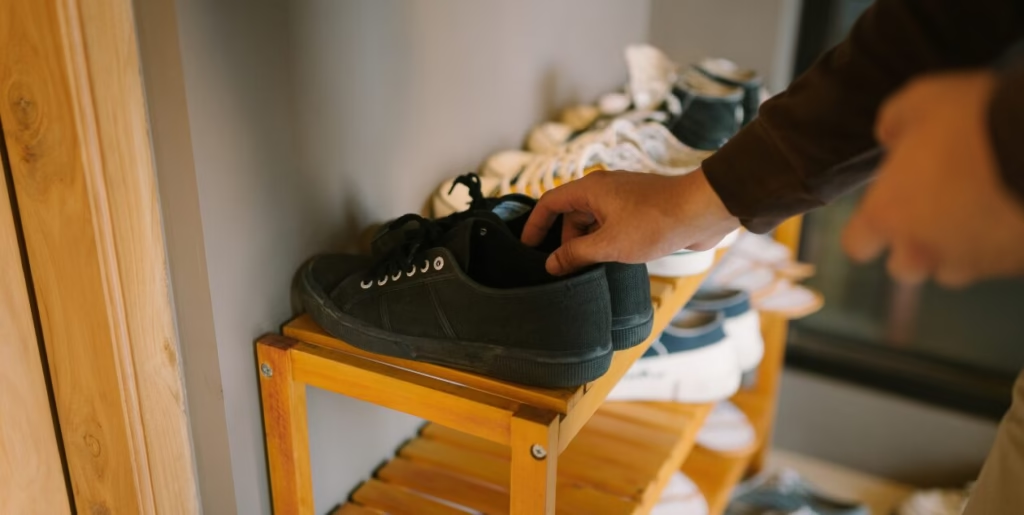
change into slippers
- 発音記号:/ʧeɪndʒ ˈɪntuː ˈslɪpərz/
- 意味: スリッパに履き替える
- 解説:日本ならではの動作。海外では案内する形で説明が必要
- 例文:I changed into the slippers they provided.
- 和訳:私は用意されたスリッパに履き替えた。

hang up one’s coat
- 発音記号:/hæŋ ʌp wʌnz koʊt/
- 意味: コートを掛ける
- 解説:玄関または廊下にコート掛けがある場合
- 例文:She hung up her coat on the rack by the hallway.
- 和訳:彼女は廊下のラックにコートを掛けた。

put away an umbrella
- 発音記号:/pʊt əˈweɪ æn ʌmˈbrɛlə/
- 意味: 傘をしまう
- 解説:雨の日の訪問時に使う実用表現
- 例文:Please put your umbrella in the umbrella stand.
- 和訳:傘立てに傘を置いてください。

⑤ 廊下を進む
walk down the hallway / corridor
- 発音記号: /wɔːk daʊn ðə ˈhɔːlweɪ/
- 意味: 廊下を歩く
- 解説:部屋に案内・移動する際の必須動作
- 例文:We walked down the hallway to the living room.
- 和訳:私たちは廊下を通ってリビングへ行った。

follow the host
- 発音記号:/ˈfɑːloʊ ðə hoʊst/
- 意味: 案内してくれる人についていく
- 解説:招かれた側の行動として自然
- 例文:I followed the host to the dining room.
- 和訳:私はホストについてダイニングルームに行った。

⑥ 部屋に入る
enter the room
- 発音記号:/ˈentər ðə ruːm/
- 意味: 部屋に入る
- 解説:到着した部屋に足を踏み入れる基本動作
- 例文:We entered the living room together.
- 和訳:一緒にリビングに入った。

be shown into the room
- 発音記号:/bi ʃoʊn ˈɪntuː ðə ruːm/
- 意味: 部屋に案内される
- 解説:丁寧な招き方やガイドに従うときの表現
- 例文:I was shown into the guest room.
- 和訳:私は客間に案内された。
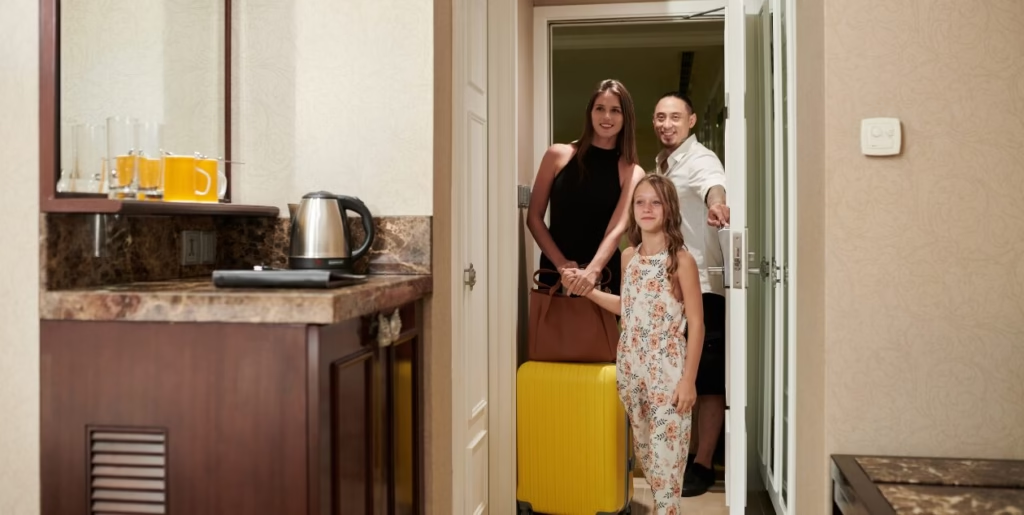
take a seat
- 発音記号:/teɪk ə siːt/
- 意味: 座る
- 解説:ホストが「Please take a seat」と案内することも多い
- 例文:Please take a seat on the sofa.
- 和訳:ソファにおかけください。

8. 訪問マナーの英語フレーズ

① 訪問前・玄関先
May I come in?
- 発音記号:/meɪ aɪ kʌm ɪn/
- 意味: 入ってもよろしいですか?
- 解説:最もシンプルで丁寧な入室前の表現
- 例文:May I come in?
- 和訳:入ってもいいですか?

Sorry to bother you.
- 発音記号: /ˈsɒri tə ˈbɑːðər juː/
- 意味: お邪魔してすみません
- 解説:玄関で声をかけるときや用件を切り出す前に便利
- 例文:Sorry to bother you at this hour.
- 和訳:こんな時間にお邪魔してすみません。

Thank you for having me.
- 発音記号:/ˈθæŋk juː fɔːr ˈhævɪŋ miː/
- 意味: 招待ありがとうございます
- 解説:ホストへの感謝の挨拶。丁寧で万能
- 例文:Thank you for having me over tonight.
- 和訳:今夜お招きいただきありがとうございます。

② 家の中に入るとき
Nice to see you. / Nice to meet you.
- 発音記号:/naɪs tə ˈsiː juː/・/miːt juː/
- 意味: お会いできて嬉しいです
- 解説:再会なら”see”、初対面なら”meet”
- 例文:Nice to see you again!
- 和訳:またお会いできて嬉しいです!

Your house is lovely.
- 発音記号:/jʊər haʊs ɪz ˈlʌvli/
- 意味: 素敵なお宅ですね
- 解説:最初の会話を和ませるフレーズ
- 例文:Your house is lovely, I love the garden.
- 和訳:素敵なお宅ですね、お庭がすてきです。
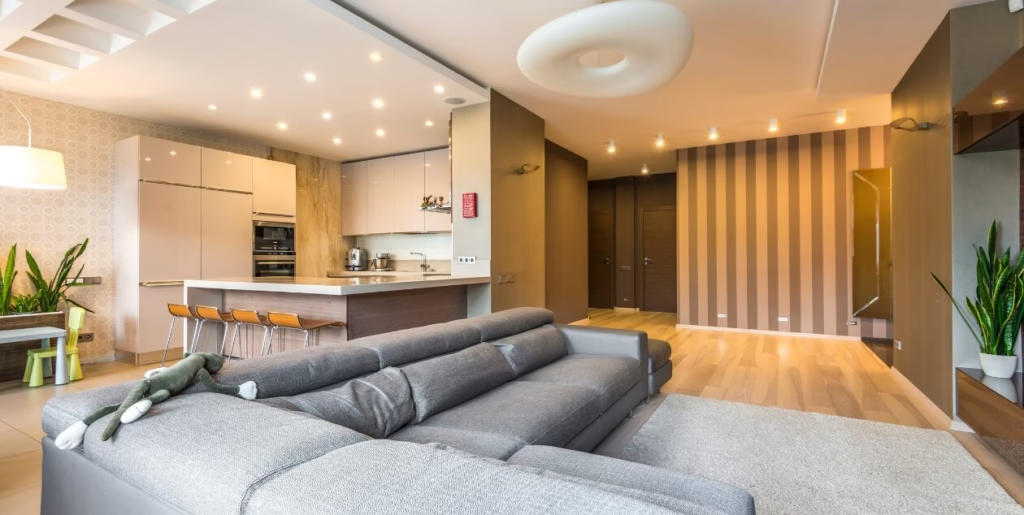
Should I take off my shoes?
- 発音記号:/ʃʊd aɪ teɪk ɒf maɪ ʃuːz/
- 意味: 靴を脱いだほうがいいですか?
- 解説:国や文化の違いを尊重するための一言
- 例文:Should I take off my shoes at the entrance?
- 和訳:玄関で靴を脱いだほうがいいですか?

③ 滞在中
I appreciate your hospitality.
- 発音記号:/aɪ əˈpriːʃieɪt jʊər ˌhɒspɪˈtæləti/
- 意味: ご親切に感謝します
- 解説:滞在中にホストに感謝を伝える定番表現
- 例文:I really appreciate your hospitality.
- 和訳:ご親切に本当に感謝します。

This is delicious.
- 発音記号:/ðɪs ɪz dɪˈlɪʃəs/
- 意味: とても美味しいです
- 解説:食事をごちそうになったときに便利
- 例文:This is delicious! Did you make it yourself?
- 和訳:とても美味しいですね!ご自身で作られたのですか?

Could I give you a hand?
- 発音記号:/kʊd aɪ ɡɪv juː ə hænd/
- 意味: お手伝いしましょうか?
- 解説:食事や片づけのとき遠慮がちに申し出る表現
- 例文:Could I give you a hand in the kitchen?
- 和訳:キッチンで手伝いましょうか?

④ 帰るとき
Thank you for your time.
- 発音記号:/ˈθæŋk juː fɔːr jʊər taɪm/
- 意味: お時間をいただきありがとうございました
- 解説:どんな訪問にも使える万能なお礼。
- 例文:Thank you for your time today.
- 和訳:今日はお時間いただきありがとうございました。

Thank you for everything.
- 発音記号:/ˈθæŋk juː fɔːr ˈɛvriθɪŋ/
- 意味: いろいろありがとうございました
- 解説:滞在全体への感謝をまとめる一言。
- 例文:Thank you for everything, I had a wonderful time.
- 和訳:いろいろありがとうございました、楽しい時間を過ごしました。

I had a wonderful time.
- 発音記号:/aɪ hæd ə ˈwʌndərfl taɪm/
- 意味: とても楽しい時間を過ごしました
- 解説:訪問を締めくくる明るいフレーズ。
- 例文:I had a wonderful time with you today.
- 和訳:今日はとても楽しい時間を過ごせました。

Hope to see you again soon.
- 発音記号:/hoʊp tə siː juː əˈɡɛn suːn/
- 意味: またすぐにお会いできたら嬉しいです
- 解説:別れ際の定番の挨拶フレーズ。
- 例文:Hope to see you again soon.
- 和訳:またすぐにお会いできたら嬉しいです。

9. 実践的な会話例

Scene 1: Approaching the house
Visitor A: This looks like the right address. Let’s walk up the driveway and head toward the entrance.
Visitor B: Yes, we’ll go through the gate, and see the fence around the front yard. The pathwaylooks beautiful with the garden lights and path lights.
Visitor A: And there’s the porch light above the front door. That makes the entrance very welcoming.
訪問者A: ここが正しい住所みたいだね。私道を歩いて玄関に向かおう。
訪問者B: うん、門をくぐって、前庭を囲っているフェンスも見えるね。小道には庭園灯や足元灯があってきれいだよ。
訪問者A: それに玄関ドアの上にはポーチライトがあるね。入口がすごく歓迎してくれている感じだね。
Scene 2: At the front door
Visitor B: Okay, let’s step onto the porch.
Visitor A: Look, their family name is on the nameplate next to the doorbell.
Visitor B: I’ll ring the doorbell now.
(Door opens, host appears.)
Host: Hello! Welcome!
Visitor A: Hello! Sorry to bother you, but we’re so glad to be here. Thank you for having me.
Host: My pleasure, please come in.
訪問者B: よし、ポーチに上がろう。
訪問者A: ドアベルの横には表札があるよ。
訪問者B: じゃあドアベルを鳴らすね。
(ドアが開き、ホストが現れる)
ホスト: こんにちは!ようこそ!
訪問者A: こんにちは!お邪魔してすみません、でもここに来れてとても嬉しいです。招待してくれてありがとうございます。
ホスト: どういたしまして。どうぞお入りください。
Scene 3: Entering the entrance
Visitor B: Nice to see you! It’s been a long time.
Visitor A: Wow, your house is lovely. I love the flowers in the flower bed by the walkway.
Visitor B: May I come in?
Host: Of course. Please, step inside.
Visitor A: Should I take off my shoes?
Host: Yes, if you don’t mind. You can put your shoes on the shoe rack and change into slippers.
Visitor B: Perfect. I’ll hang up my coat on this rack by the hallway.
Visitor A: And I’ll put away my umbrella in the umbrella stand near the doormat.
訪問者B: お会いできて嬉しいです!本当に久しぶりだね。
訪問者A: 素敵なお宅ですね。小道沿いの花壇もとてもきれいです。
訪問者B: 入ってもよろしいですか?
ホスト: もちろんです。どうぞ中へお入りください。
訪問者A: 靴を脱いだほうがいいですか?
ホスト: はい、よろしければ。靴は靴棚に置いて、スリッパに履き替えてください。
訪問者B: いいですね。この廊下のハンガーにコートを掛けます。
訪問者A: それから、玄関マットのそばにある傘立てに傘をしまっておきますね。
Scene 4: Walking down the hallway
Host: Please follow the host to the living room.
Visitor A: Sure, let’s walk down the hallway together.
Visitor B: I notice the light switch here, and the handrail looks very solid.
Visitor A: Oh, be careful at the threshold, it’s a bit high.
ホスト: リビングルームまで案内しますので、私についてきてください。
訪問者A: はい、一緒に廊下を歩きましょう。
訪問者B: ここに電気のスイッチがあるんですね。手すりもしっかりしている。
訪問者A: あっ、ここの敷居は少し高いので気をつけて。
Scene 5: In the living room
Host: Please take a seat on the sofa.
Visitor A: Thank you. I appreciate your hospitality.
Visitor B: This tea is amazing. This is delicious!
Visitor A: Would you like some help later? Could I give you a hand in the kitchen?
Host: That’s very kind, but no need. Relax and enjoy. Look, from here you can see the backyard, the lawn, and even our wooden deck.
ホスト: ソファにお掛けください。
訪問者A: ありがとうございます。ご親切に感謝します。
訪問者B: このお茶、とても美味しいです。
訪問者A: 後で何かお手伝いしましょうか?キッチンでお手伝いできますよ。
ホスト: ありがとうございます、でもごゆっくりなさってください。ここから裏庭や芝生、それに木のデッキもご覧いただけますよ。
Scene 6: Security and garden talk
Visitor A: Oh, I see the security camera above the garage. That must make you feel safe.
Visitor B: Yes, and the motion sensor turns on the security light at night, right?
Host: Exactly. Our security system and deadbolt locks help keep everything safe.
Visitor A: Nice! And the patio looks perfect for summer dinners.
訪問者A: あのガレージの上にあるのは防犯カメラですか?それは安心できますね。
訪問者B: それに人感センサーが夜になると防犯ライトを点けてくれるんですよね?
ホスト: そうなんです。セキュリティシステムとデッドボルト錠で安全を保っています。
訪問者A: いいですね!パティオも夏のディナーにぴったりですね。
Scene 7: Leaving the house
Visitor A: Time flies. Thank you for your time today.
Visitor B: Yes, thank you for everything. I had a wonderful time.
Visitor A: Hope to see you again soon.
Host: Absolutely, you’re always welcome. Have a safe trip home!
訪問者A: あっという間ですね。今日はお時間いただきありがとうございました。
訪問者B: 本当に。いろいろありがとうございました。とても楽しい時間を過ごせました。
訪問者A: またすぐにお会いできるのを楽しみにしています。
ホスト: もちろん、いつでもお越しください。気をつけてお帰りください!
10. ” Typical American Entrance, Hallway, and Exterior”をよんでみましょう!
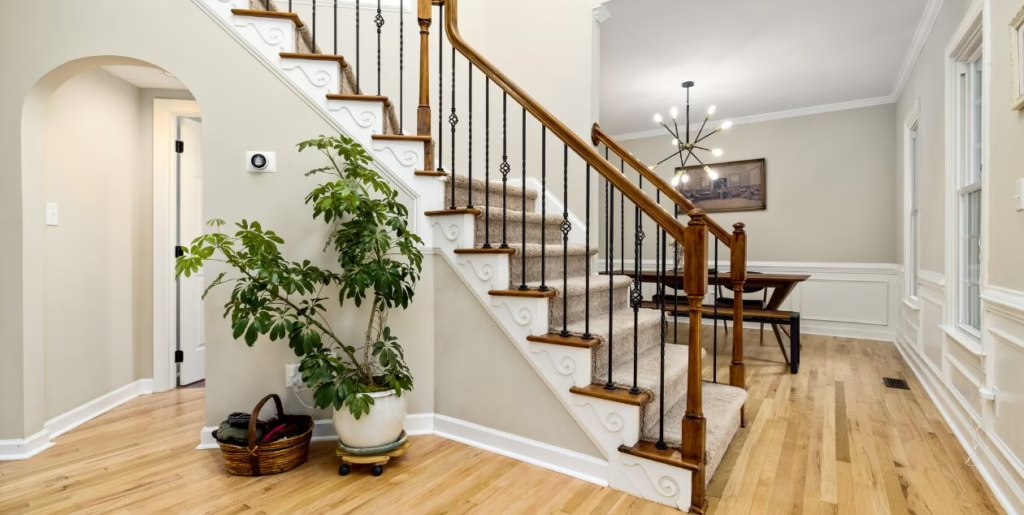
Typical American Entrance, Hallway, and Exterior
When you approach a typical American home, the first feature you’ll likely notice is the front yard, which is often defined by a neat fence or a line of shrubs. A paved driveway leads up to the house, offering space not only for parking but also for welcoming guests. Flanking the path, you might find garden lights or path lights illuminating a charming walkway that guides you from the curb directly to the home’s entrance.
The American front door is more than just a functional feature; it’s a focal point for the house’s curb appeal. Many houses display a decorative nameplate or doorplate next to the doorway, sometimes with a colorful doormat or welcome mat that greets visitors. Above the doorway, a porch light is almost always found, ensuring the porch is both safe and inviting in the evenings. This porch, often wide enough for a bench or a couple of chairs, is a classic spot for neighbors to chat or for the household to relax outside.
Home security is also important to many Americans. You may notice a security camera or surveillance camera discreetly mounted by the entrance, sometimes paired with a motion sensoror a security light that springs to life when someone walks by at night. Sturdy deadbolt locks and a comprehensive security system help protect the household, while a mailbox or letterbox stands ready to receive daily deliveries.
Upon reaching the entrance, guests commonly ring the doorbell or use an intercom to announce their arrival. After being greeted, visitors usually step onto the porch and wait at the front door. In some regions, it’s customary to knock on the door instead, though both practices are used.
Stepping inside, one finds themselves in the entryway or foyer—the transitional space between the exterior and the rest of the home. Here, you’ll often see a shoe rack or shoe shelf, offering a convenient place for guests to take off their shoes and, in some homes, change into slippers. An umbrella stand is frequently placed near the door for rainy days. The style of the foyer reflects the personality of the home: some are bright and open with mirrors and decor, while others might display an elegant rug, a console table, or a cozy bench for sitting down while removing footwear.
The hallway or corridor stretches out from the entrance, connecting all the main rooms. American hallways typically have a light switch near the entry, and sometimes a handrail if stairs are nearby. The threshold at the end of the entry may separate the foyer from the rest of the living space. Wide hallways often display family photos, artwork, or practical elements like a coat rack or storage bench.
American exteriors are not complete without a garage—a signature feature for car-centric lifestyles. The backyard, often accessed through a side gate, may include a deck, a patio, and a lush lawn or flower bed. Outdoor living spaces like the deck or patio are used for barbecues, family gatherings, or just relaxing after work.
Together, these details form the quintessential American home experience: a welcoming entrance, a practical and expressive hallway, and functional, attractive exterior spaces. Each feature—from the porch light to the security system, the doormat to the mailbox—is part of an environment that values comfort, hospitality, and a sense of belonging.
典型的なアメリカの玄関・廊下・外まわり
典型的なアメリカの住宅に近づくと、まず目に入るのは整った前庭(front yard)で、普通はきれいに整えられたフェンス(fence)や低木で囲まれています。舗装された車道(driveway)が家まで続き、駐車だけでなく訪問客を迎える道としての役割も果たします。道の両脇には庭園灯(garden lights)や小道灯(path lights)が並び、歩行者を家の入り口(entrance)へ優雅に誘います。
アメリカの住宅の玄関ドア(front door)は、単なる出入り口以上の存在で、多くの家にはその横に装飾的な表札(nameplate / doorplate)があります。足元には招待の気持ちを表す玄関マット(doormat / welcome mat)が置かれ、上方には夜間の安全と歓迎を示すポーチライト(porch light)が設置されています。ポーチ(porch)はしばしばベンチや椅子が置かれ、近隣と交流する場所にもなります。
防犯設備も重要視されており、防犯カメラ(security camera / surveillance camera)が目立たないように設置され、人感センサー(motion sensor)が動きを感知すると防犯ライト(security light)が点灯します。頑丈なデッドボルト錠(deadbolt lock)や高度なセキュリティシステム(security system)で家の安全を守っています。さらに毎日の郵便物を受け取る郵便受け(mailbox / letterbox)も玄関のそばに備えられています。
訪問者はこれらを通り、まずドアベル(doorbell)を鳴らすか、時にはインターホン(intercom)を使って到着を知らせます。訪問先の家では、訪問者がポーチに上がる(step onto the porch)のを待ち受け、場合によってはドアをノック(knock on the door)して迎えます。
中に入るとそこは玄関ホール(entryway / foyer)で、訪問者はここで靴を脱ぎ、整理できる靴棚(shoe rack / shoe shelf)や、雨の日のための傘立て(umbrella stand)があります。アメリカの多くの家庭では、訪問者が靴を脱ぐ習慣は日本ほど一般的ではないものの、このスペースは人を迎えるための最初の印象を決める重要な場所です。装飾的な鏡やラグ、コンソールテーブルなどで個性的な空間を演出しています。
玄関からつながる廊下(hallway / corridor)は家の各部屋をつなぎます。廊下付近には操作しやすい場所に照明スイッチ(light switch)があり、階段がある場合は手すりにあたる手すり(handrail / railings)も設置されています。部屋に入るための敷居にあたる段差(threshold)は注意が必要なこともあり、家のデザインによる幅広い特徴があります。
アメリカの住宅の外観は多くの場合、車を収容するガレージ(garage)を伴います。裏庭へ通じる門(gate)をくぐると、家族がバーベキューをしたりくつろいだりするためのデッキ(deck)やパティオ(patio)、手入れの行き届いた芝生(lawn)や花壇(flower bed)が広がっています。
これらアメリカ住宅の細部は、ポーチライトからセキュリティシステム、玄関マットや郵便受けに至るまで、快適さとホスピタリティ、そして安全性を大切にしています。このようにして形成された空間は、訪れる人々に温かな歓迎とともに、家族の「おもてなし」精神を体現しています。
まとめ

この記事では、玄関から庭、防犯設備、そして訪問マナーに至るまで、家まわりに関する英語表現を幅広くご紹介しました。
「front door(玄関ドア)」や「hallway(廊下)」といった基本的な単語から、「deadbolt lock(デッドボルト錠)」や「motion sensor(人感センサー)」のような専門的な英単語まで、海外生活で役立つフレーズを網羅的に学ぶことができたかと思います。
学習アドバイス
- 場面をイメージして使う: 単語やフレーズをただ暗記するのではなく、訪問する場面や、自分の家を案内する場面を具体的に想像しながら声に出して練習してみましょう。ロールプレイング形式で会話例を試してみるのも効果的です。
- 身近なものから表現してみる: 自分の家の玄関、廊下、庭にあるものを英語で何と言うか、実際に声に出してみることから始めてみましょう。「My house has a small porch and a big driveway」のように、身近なものを英語で表現する練習を繰り返すことで、日常会話力が自然に身につきます。
- 関連キーワードで検索してみる: 興味を持った英単語(例:
doorknob)を、Google画像検索やYouTubeなどで調べてみましょう。ネイティブがどのようにその単語を使っているか、視覚的に理解を深めることができます。
今回学んだ英語表現が、あなたの日常会話をさらに豊かにする一助となれば幸いです。
英語・英会話の基礎を学びたい方はこちらから! ↓

語彙力強化したい方はこちらから! ↓
















